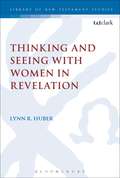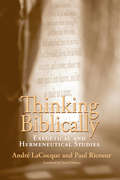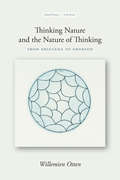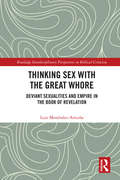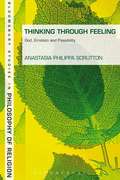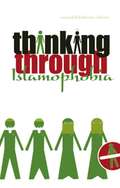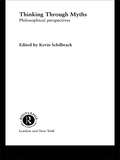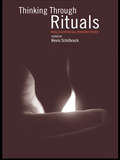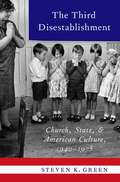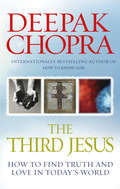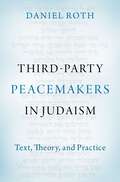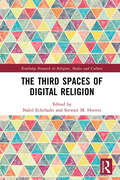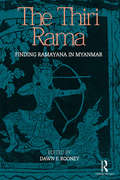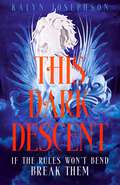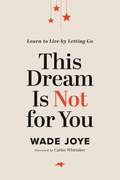- Table View
- List View
Thinking and Seeing with Women in Revelation (The Library of New Testament Studies #475)
by Lynn R. HuberLynn R. Huber argues that the visionaryaspect of Revelation, with its use of metaphorical thinking and language, isthe crux of the text's persuasive power. Emerging from a context that employsimagery to promote imperial mythologies, Revelation draws upon a long traditionof using feminine imagery as a tool of persuasion. It does so even whileshaping a community identity in contrast to the dominant culture and inexclusive relationship with the Lamb. By drawing upon the work of medieval and modern visionaries, Huber answers acall to examine the way 'real' readers engage with biblical texts. Revealinghow Revelation continues to persuade audiences through appeals to the visualand provocative imagery she offers a new sense of how the text metaphoricallanguage simultaneously limits and invites new meaning, unfurling a range ofinterpretations.
Thinking Biblically: Exegetical and Hermeneutical Studies
by André LaCocque Paul RicoeurUnparalled in its poetry, richness, and religious and historical significance, the Hebrew Bible has been the site and center of countless commentaries, perhaps none as unique as Thinking Biblically. This remarkable collaboration sets the words of a distinguished biblical scholar, André LaCocque, and those of a leading philosopher, Paul Ricoeur, in dialogue around six crucial passages from the Old Testament: the story of Adam and Eve; the commandment "thou shalt not kill"; the valley of dry bones passage from Ezekiel; Psalm 22; the Song of Songs; and the naming of God in Exodus 3:14. Commenting on these texts, LaCocque and Ricoeur provide a wealth of new insights into the meaning of the different genres of the Old Testament as these made their way into and were transformed by the New Testament. LaCocque's commentaries employ a historical-critical method that takes into account archaeological, philological, and historical research. LaCocque includes in his essays historical information about the dynamic tradition of reading scripture, opening his exegesis to developments and enrichments subsequent to the production of the original literary text. Ricoeur also takes into account the relation between the texts and the historical communities that read and interpreted them, but he broadens his scope to include philosophical speculation. His commentaries highlight the metaphorical structure of the passages and how they have served as catalysts for philosophical thinking from the Greeks to the modern age. This extraordinary literary and historical venture reads the Bible through two different but complementary lenses, revealing the familiar texts as vibrant, philosophically consequential, and unceasingly absorbing.
Thinking Nature and the Nature of Thinking: From Eriugena to Emerson (Cultural Memory in the Present)
by Willemien OttenA fresh and more capacious reading of the Western religious tradition on nature and creation, Thinking Nature and the Nature of Thinking puts medieval Irish theologian John Scottus Eriugena (810–877) into conversation with American philosopher Ralph Waldo Emerson (1803–1882). Challenging the biblical stewardship model of nature and histories of nature and religion that pit orthodoxy against the heresy of pantheism, Willemien Otten reveals a line of thought that has long made room for nature's agency as the coworker of God. Embracing in this more elusive idea of nature in a world beset by environmental crisis, she suggests, will allow us to see nature not as a victim but as an ally in a common quest for re-attunement to the divine. Putting its protagonists into further dialogue with such classic authors as Augustine, Maximus the Confessor, Friedrich Schleiermacher, and William James, her study deconstructs the idea of pantheism and paves the way for a new natural theology.
Thinking Sex with the Great Whore: Deviant Sexualities and Empire in the Book of Revelation (Routledge Interdisciplinary Perspectives on Biblical Criticism)
by Luis Menéndez-AntuñaMany scholars in Biblical and Revelation studies have written at length about the imperial and patriarchal implications of the figure of the Whore of Babylon. However, much of the focus has been on the links to the Roman Empire and ancient attitudes towards gender. This book adds another layer to the conversation around this evocative figure by pursuing an ideological critique of the Great Whore that takes into account contemporary understandings of sexuality, and in so doing advances a de-moralization of apparent sexual deviancy both in the present and in the past. Offering an emancipatory reading of Revelation 17-18 using Foucauldian, postcolonial and queer historiographies, this study sets out alternative paths for identity construction in Biblical texts. By using these alternative critical lenses, the author argues that the common neglect of the ethical and political impact of Biblical texts in the present can be overcome. This, in turn, allows for fresh reflection on the study of the Bible and its implications for progressive politics. Situated at the intersection of Revelation Studies, Biblical Studies and Hermeneutics, as well as Contextual/Liberationist Theologies and Queer and Postcolonial Criticism, this is a cutting edge study that will be of keen interest to scholars of Theology and Religious Studies.
Thinking Sex with the Great Whore: Deviant Sexualities and Empire in the Book of Revelation (Routledge Interdisciplinary Perspectives on Biblical Criticism)
by Luis Menéndez-AntuñaMany scholars in Biblical and Revelation studies have written at length about the imperial and patriarchal implications of the figure of the Whore of Babylon. However, much of the focus has been on the links to the Roman Empire and ancient attitudes towards gender. This book adds another layer to the conversation around this evocative figure by pursuing an ideological critique of the Great Whore that takes into account contemporary understandings of sexuality, and in so doing advances a de-moralization of apparent sexual deviancy both in the present and in the past. Offering an emancipatory reading of Revelation 17-18 using Foucauldian, postcolonial and queer historiographies, this study sets out alternative paths for identity construction in Biblical texts. By using these alternative critical lenses, the author argues that the common neglect of the ethical and political impact of Biblical texts in the present can be overcome. This, in turn, allows for fresh reflection on the study of the Bible and its implications for progressive politics. Situated at the intersection of Revelation Studies, Biblical Studies and Hermeneutics, as well as Contextual/Liberationist Theologies and Queer and Postcolonial Criticism, this is a cutting edge study that will be of keen interest to scholars of Theology and Religious Studies.
Thinking Through Feeling: God, Emotion and Passibility (Continuum Studies in Philosophy of Religion)
by Anastasia Philippa ScruttonContemporary debates on God's emotionality are divided between two extremes. Impassibilists deny God's emotionality on the basis of God's omniscience, omnipotence and incorporeality. Passibilists seem to break with tradition by affirming divine emotionality, often focusing on the idea that God suffers with us. Contemporary philosophy of emotion reflects this divide. Some philosophers argue that emotions are voluntary and intelligent mental events, making them potentially compatible with omniscience and omnipotence. Others claim that emotions are involuntary and basically physiological, rendering them inconsistent with traditional divine attributes. Thinking Through Feeling: God, Emotion and Passibility creates a three-way conversation between the debate in theology, contemporary philosophy of emotion, and pre-modern (particularly Augustinian and Thomist) conceptions of human affective experience. It also provides an exploration of the intelligence and value of the emotions of compassion, anger and jealousy.
Thinking Through Feeling: God, Emotion and Passibility (Continuum Studies in Philosophy of Religion #1)
by Anastasia Philippa ScruttonContemporary debates on God's emotionality are divided between two extremes. Impassibilists deny God's emotionality on the basis of God's omniscience, omnipotence and incorporeality. Passibilists seem to break with tradition by affirming divine emotionality, often focusing on the idea that God suffers with us. Contemporary philosophy of emotion reflects this divide. Some philosophers argue that emotions are voluntary and intelligent mental events, making them potentially compatible with omniscience and omnipotence. Others claim that emotions are involuntary and basically physiological, rendering them inconsistent with traditional divine attributes. Thinking Through Feeling: God, Emotion and Passibility creates a three-way conversation between the debate in theology, contemporary philosophy of emotion, and pre-modern (particularly Augustinian and Thomist) conceptions of human affective experience. It also provides an exploration of the intelligence and value of the emotions of compassion, anger and jealousy.
Thinking Through Islamophobia (PDF)
by Abdoolkarim Vakil Salman SayyidThis title investigates the concept of Islamophobia as a global phenomenon and rigorously analyses its many meanings. The contributors map out the concept in terms of its relationship to practices such as anti-Semitism and racism. They argue that it should be taken seriously and not dismissed as just polemic.
Thinking Through Myths: Philosophical Perspectives
by Kevin SchilbrackEight outstanding essays, from leading academics, deconstruct perennial problems of rationality, imagination and narrative to trace the influence of myth in our own beliefs, origins, and potential futures. Thinking Through Myths attempts to reconcile the opposed claims of pragmatism and beauty, calling for the acknowledgement of myths in everyday experience.
Thinking Through Myths: Philosophical Perspectives
by Kevin SchilbrackEight outstanding essays, from leading academics, deconstruct perennial problems of rationality, imagination and narrative to trace the influence of myth in our own beliefs, origins, and potential futures. Thinking Through Myths attempts to reconcile the opposed claims of pragmatism and beauty, calling for the acknowledgement of myths in everyday experience.
Thinking Through Rituals: Philosophical Perspectives
by Kevin SchilbrackMany philosophical approaches today seek to overcome the division between mind and body. If such projects succeed, then thinking is not restricted to the disembodied mind, but is in some sense done through the body. From a post-Cartesian perspective, then, ritual activities that discipline the body are not just thoughtless motions, but crucial parts of the way people think.Thinking Through Rituals explores religious ritual acts and their connection to meaning and truth, belief, memory, inquiry, worldview and ethics. Drawing on philosophers such as Foucault, Merleau-Ponty and Wittgenstein, and sources from cognitive science, pragmatism and feminist theory, it provides philosophical resources for understanding religious ritual practices like the Christian Eucharistic ceremony, Hatha Yoga, sacred meditation or liturgical speech. Its essays consider a wide variety of rituals in Christianity, Judaism, Hinduism and Buddhism - including political protest rituals and gay commitment ceremonies, traditional Vedic and Yogic rites, Christian and Buddhist meditation and the Jewish Shabbat. They challenge the traditional disjunction between thought and action, showing how philosophy can help to illuminate the relationship between doing and meaning which ritual practices imply.
Thinking Through Rituals: Philosophical Perspectives
by Kevin SchilbrackMany philosophical approaches today seek to overcome the division between mind and body. If such projects succeed, then thinking is not restricted to the disembodied mind, but is in some sense done through the body. From a post-Cartesian perspective, then, ritual activities that discipline the body are not just thoughtless motions, but crucial parts of the way people think.Thinking Through Rituals explores religious ritual acts and their connection to meaning and truth, belief, memory, inquiry, worldview and ethics. Drawing on philosophers such as Foucault, Merleau-Ponty and Wittgenstein, and sources from cognitive science, pragmatism and feminist theory, it provides philosophical resources for understanding religious ritual practices like the Christian Eucharistic ceremony, Hatha Yoga, sacred meditation or liturgical speech. Its essays consider a wide variety of rituals in Christianity, Judaism, Hinduism and Buddhism - including political protest rituals and gay commitment ceremonies, traditional Vedic and Yogic rites, Christian and Buddhist meditation and the Jewish Shabbat. They challenge the traditional disjunction between thought and action, showing how philosophy can help to illuminate the relationship between doing and meaning which ritual practices imply.
The Third Disestablishment: Church, State, and American Culture, 1940-1975
by Steven K. GreenIn 1947, the Supreme Court embraced the concept of church-state separation as shorthand for the meaning of the Establishment Clause of the First Amendment. The concept became embedded in Court's jurisprudence and remains so today. Yet separation of church and state is not just a legal construct; it is embedded in the culture. Church-state separation was a popular cultural ideal, chiefly for Protestants and secularists, long before the Supreme Court adopted it as a constitutional principle. While the Court's church-state decisions have impacted public attitudes--particularly those controversial holdings regarding prayer and Bible reading in public schools--the idea of church-state separation has remained relatively popular; recent studies indicate that approximately two-thirds of Americans support the concept, even though they disagree over how to apply it. In the follow up to his 2010 book The Second Disestablishment, Steven K. Green sets out to do examine the development of modern separationism from a legal and cultural perspective. The Third Disestablishment examines the dominant religious-cultural conflicts of the 1930s-1950s between Protestants and Catholics, but it also shows how other trends and controversies during mid-century impacted both judicial and popular attitudes toward church-state separation: the Jehovah's Witnesses' cases of the late-30s and early-40's, Cold War anti-communism, the religious revival and the rise of civil religion, the advent of ecumenism, and the presidential campaign of 1960. The book then examines how events of the 1960s-the school prayer decisions, the reforms of Vatican II, and the enactment of comprehensive federal education legislation providing assistance to religious schools-produced a rupture in the Protestant consensus over church-state separation, causing both evangelicals and religious progressives to rethink their commitment to that principle. Green concludes by examining a series of church-state cases in the late-60s and early-70s where the justices applied notions of church-state separation at the same time they were reevaluating that concept.
The Third Disestablishment: Church, State, and American Culture, 1940-1975
by Steven K. GreenIn 1947, the Supreme Court embraced the concept of church-state separation as shorthand for the meaning of the Establishment Clause of the First Amendment. The concept became embedded in Court's jurisprudence and remains so today. Yet separation of church and state is not just a legal construct; it is embedded in the culture. Church-state separation was a popular cultural ideal, chiefly for Protestants and secularists, long before the Supreme Court adopted it as a constitutional principle. While the Court's church-state decisions have impacted public attitudes--particularly those controversial holdings regarding prayer and Bible reading in public schools--the idea of church-state separation has remained relatively popular; recent studies indicate that approximately two-thirds of Americans support the concept, even though they disagree over how to apply it. In the follow up to his 2010 book The Second Disestablishment, Steven K. Green sets out to do examine the development of modern separationism from a legal and cultural perspective. The Third Disestablishment examines the dominant religious-cultural conflicts of the 1930s-1950s between Protestants and Catholics, but it also shows how other trends and controversies during mid-century impacted both judicial and popular attitudes toward church-state separation: the Jehovah's Witnesses' cases of the late-30s and early-40's, Cold War anti-communism, the religious revival and the rise of civil religion, the advent of ecumenism, and the presidential campaign of 1960. The book then examines how events of the 1960s-the school prayer decisions, the reforms of Vatican II, and the enactment of comprehensive federal education legislation providing assistance to religious schools-produced a rupture in the Protestant consensus over church-state separation, causing both evangelicals and religious progressives to rethink their commitment to that principle. Green concludes by examining a series of church-state cases in the late-60s and early-70s where the justices applied notions of church-state separation at the same time they were reevaluating that concept.
The Third Jesus: How to Find Truth and Love in Today's World
by Dr Deepak ChopraIn this dazzling book, one of the most influential spiritual thinkers of our time provides an answer that is as challenging as it is uplifting. Deepak Chopra searches for the Christ who stands at the heart of Christianity and discovers the identity of Jesus is threefold.Firstly, there is Jesus the man, who lived over 2000 years ago and whose sermons form the foundation of Christian theology. Secondly, there is Jesus the Son of God, who represents a specific branch of religion. Finally, there is the Third Jesus, the spiritual guide whose teachings embrace humanity as a whole.By considering each of these separate figures, Chopra allows us to decide for ourselves which of them speaks the most clearly to us today. As we become familiar with the universal wisdom of Christ, most especially through the guidance of the Third Jesus, we may become more open to a truly loving spirituality. And we will begin to create a brighter future, free from hatred fuelled by religious fundamentalism.
Third-Party Peacemakers in Judaism: Text, Theory, and Practice
by Daniel RothIn the race to discover real solutions for the conflicts that plague contemporary society, it is essential that we look to precedent. Many of today's conflicts involve ethno-religious tensions that modern wisdom alone is ill-equipped to resolve. In Third-Party Peacemakers in Judaism, Rabbi Dr. Daniel Roth asks us to consider ancient religious and traditional cultural solutions to such present-day issues. Roth presents thirty-six case studies featuring third-party peacemakers drawn from Jewish classical, medieval, and early-modern rabbinic literature. Each case is explored through three layers of analysis - text, theory, and practice. The first layer offers historical and literary analysis of textual case studies, many of which are critically analyzed here for the first time. The second layer examines the theoretical model of third-party peacemaking imbedded within the selected cases and comparing them to other cultural and religious models of third-party peacemaking and conflict resolution. The final layer of analysis, based upon the author's personal experience of religious conflict resolution and peacemaking, looks at the practical implications of these case studies as models for modern peacemaking. Third-Party Peacemakers in Judaism serves as an inspiration for fostering indigenous practices of third-party peacemaking and mediation in the modern era.
Third-Party Peacemakers in Judaism: Text, Theory, and Practice
by Daniel RothIn the race to discover real solutions for the conflicts that plague contemporary society, it is essential that we look to precedent. Many of today's conflicts involve ethno-religious tensions that modern wisdom alone is ill-equipped to resolve. In Third-Party Peacemakers in Judaism, Rabbi Dr. Daniel Roth asks us to consider ancient religious and traditional cultural solutions to such present-day issues. Roth presents thirty-six case studies featuring third-party peacemakers drawn from Jewish classical, medieval, and early-modern rabbinic literature. Each case is explored through three layers of analysis - text, theory, and practice. The first layer offers historical and literary analysis of textual case studies, many of which are critically analyzed here for the first time. The second layer examines the theoretical model of third-party peacemaking imbedded within the selected cases and comparing them to other cultural and religious models of third-party peacemaking and conflict resolution. The final layer of analysis, based upon the author's personal experience of religious conflict resolution and peacemaking, looks at the practical implications of these case studies as models for modern peacemaking. Third-Party Peacemakers in Judaism serves as an inspiration for fostering indigenous practices of third-party peacemaking and mediation in the modern era.
The Third Spaces of Digital Religion (Routledge Research in Religion, Media and Culture)
by Nabil Echchaibi Stewart M. HooverThis exciting volume explores how religious meaning is generated and performed in our present digital media ecosystem. It uses the spatial metaphor of a third space to visualize the mobility of everyday religion and to explore the dynamic ways in which contemporary subjects imagine, produce, and navigate new religious and spiritual places. Comprised of seven original essays, this book provides a rigorous discussion of the complex intersections of the digital and religion, demonstrating how third spaces of religion stand out by virtue of their in-betweenness. They exist between private and public, between institution and individual, between authority and individual autonomy, between large media framings and individual "pro-sumption," and between local and translocal. Including probing analysis of how Muslim, Catholic, and Neo-Pagan identities are cultivated and developed online, case studies reflect on the creative outcomes of this condition of in-betweenness and the emergence of other places of religious and spiritual meaning. Blending theoretical analysis with grounded empirical research, this book is essential reading for students and scholars of contemporary religion, media and religion, sociology of religion, religion, and popular culture.
The Third Spaces of Digital Religion (Routledge Research in Religion, Media and Culture)
by Nabil Echchaibi Stewart M. HooverThis exciting volume explores how religious meaning is generated and performed in our present digital media ecosystem. It uses the spatial metaphor of a third space to visualize the mobility of everyday religion and to explore the dynamic ways in which contemporary subjects imagine, produce, and navigate new religious and spiritual places. Comprised of seven original essays, this book provides a rigorous discussion of the complex intersections of the digital and religion, demonstrating how third spaces of religion stand out by virtue of their in-betweenness. They exist between private and public, between institution and individual, between authority and individual autonomy, between large media framings and individual "pro-sumption," and between local and translocal. Including probing analysis of how Muslim, Catholic, and Neo-Pagan identities are cultivated and developed online, case studies reflect on the creative outcomes of this condition of in-betweenness and the emergence of other places of religious and spiritual meaning. Blending theoretical analysis with grounded empirical research, this book is essential reading for students and scholars of contemporary religion, media and religion, sociology of religion, religion, and popular culture.
The Thiri Rama: Finding Ramayana in Myanmar
by Dawn F. RooneyThe Thiri Rama – or the Great Rama – was written for court performance and is the only known illustrated version of the Ramayana story in Myanmar. Based on palm-leaf manuscripts and scenes carved on over 300 sandstone plaques at a mid-nineteenth-century Buddhist pagoda west of Mandalay in Myanmar, this book presents an original translation of the Thiri Rama rendered in prose. The volume also includes essays on the history and tradition of the Ramayana in Myanmar as well as the cultural context in which the play was performed. It contains many helpful resources, incorporating a glossary and a list of characters and their corresponding personae in Valmiki’s Ramayana. With over 250 fascinating visuals and core text contributions by distinguished Burmese scholars, U Thaw Kaung, Tin Maung Kyi, and U Aung Thwin, this book will greatly interest scholars and researchers of South and Southeast Asian culture, literary forms, epics, art and art history, theatre and performance studies, religion, especially those concerned with Hinduism, as well as folklorists.
The Thiri Rama: Finding Ramayana in Myanmar
by Dawn F. RooneyThe Thiri Rama – or the Great Rama – was written for court performance and is the only known illustrated version of the Ramayana story in Myanmar. Based on palm-leaf manuscripts and scenes carved on over 300 sandstone plaques at a mid-nineteenth-century Buddhist pagoda west of Mandalay in Myanmar, this book presents an original translation of the Thiri Rama rendered in prose. The volume also includes essays on the history and tradition of the Ramayana in Myanmar as well as the cultural context in which the play was performed. It contains many helpful resources, incorporating a glossary and a list of characters and their corresponding personae in Valmiki’s Ramayana. With over 250 fascinating visuals and core text contributions by distinguished Burmese scholars, U Thaw Kaung, Tin Maung Kyi, and U Aung Thwin, this book will greatly interest scholars and researchers of South and Southeast Asian culture, literary forms, epics, art and art history, theatre and performance studies, religion, especially those concerned with Hinduism, as well as folklorists.
Thirukailaya Gyana Ula
by Seraman Perumal NayanarThis work is part of the 11th Thirumurai.'Ula' is one of the 96 types of 'Sitrillakiyam'. Also called 'Adhi Ula' as it is the first in the Ula genre.It talks in praise of Lord Shiva and how women of all ages are mesmerized by his charisma.
Thiruppavai
by AndalPart of Naalayira thivvya prabantham, Thriuppavai is a collection of 30 songs sung by Andal in praise of the Lord Mahavishnu. These songs are sung typically in the Tamil month of marghazhi culminating in the pongal festival in the month of Thai. It is said that Andal merged one with God at the end of these thirty days.
This Dark Descent: Enter the Illinir, the cut-throat horse race where your options are win - or die
by Kalyn JosephsonEnter the corrupt world of Veradell, where warring monarchs vie for a kingdom full of forbidden magic, illicit romance and cut-throat horse racing. Steeped in Jewish folklore, This Dark Descent is an explosive YA fantasy by Kalyn Josephson, perfect for fans of Leigh Bardugo's Six of Crows.Mikira Rusel is out of options. With her father imprisoned and facing rising debts, there’s only one way to save her family from ruin: enter the Illinir, a high-stakes, cross-country horse race known for its high death toll as much as its flashy prize money.To have any chance of success she’ll have to recruit Ari, an unlicensed enchanter, Damien, a lord in the midst of a succession battle, and Reid; the brooding horse trainer who will be the key to Mikira’s survival.All her accomplices have reasons of their own to help Mikira - and their own blood feuds to avenge. And as alliances deepen and romances form, Mikira will have to discover where everyone’s true loyalties lie.In a world as dangerous as this, remember to keep your enemies close and your friends closer . . .
This Dream Is Not for You: Learn to Live by Letting Go
by Wade JoyeChristian speaker and Bible teacher Wade Joye pushes back against the dominant self-help teaching of the day—to follow your dreams—and encourages us to let go and surrender our lives to God in order to truly live. &“Follow your dreams&” is the self-help message of our day. In our schools and universities, media, and culture, and even in church, we are taught to dream big, work hard, and find true happiness in living our dreams. And so we spend our lives chasing. But as we chase our dreams, we can be met with exhaustion, anxiety, and disappointment. Our circumstances may put our dreams in jeopardy, or even deny them—and we&’re heartbroken. Or we achieve them and just want more. Wade Joye offers here a different way. Release your grip on your dreams and trust God with your whole life. Joye shows that by letting go we are freed from the pressure to secure some ideal, unattainable life, and instead become open to God and his plans. Living a life of daily surrender to God&’s purpose we begin to see glimpses of God in our present circumstance, as he shows us that he, more than anyone, can be trusted. With deep wisdom, frank teaching, and a pastor&’s heart, Wade guides readers step-by-step to the place of letting go, the place where we find real life.
